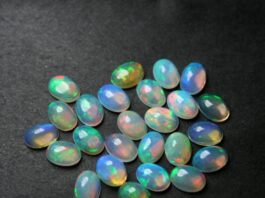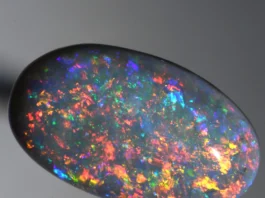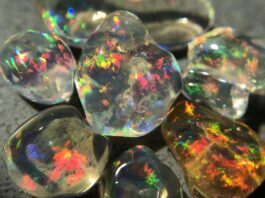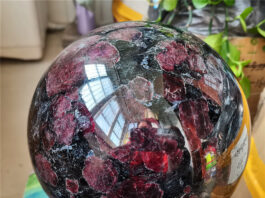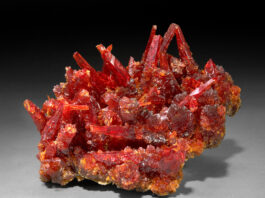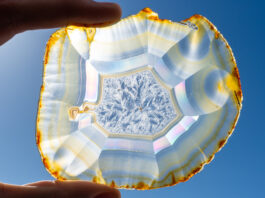Prase quartz is a captivating variety of quartz renowned for its distinctive green coloration. This gemstone owes its verdant hues to the presence of various mineral inclusions, and it holds significance both in the world of gemology and in metaphysical and holistic practices. In this overview, we’ll delve into the definition, characteristics, and uses of prase quartz, shedding light on its unique properties and cultural importance.


Prase quartz, often simply referred to as prase, is a form of quartz characterized by its lush green color. This coloration arises due to the inclusion of minerals like chlorite, actinolite, or amphibole within the quartz crystal structure. The inclusions may appear as fibrous or needle-like structures, creating varying shades of green from pale to deep and sometimes exhibiting a mossy appearance. Prase quartz shares the hexagonal crystal structure common to all quartz varieties, typically forming prismatic crystals with pointed terminations.
Significance and Uses:
- Aesthetic and Gemstone Value: Prase quartz is highly regarded for its aesthetic qualities and is often used in jewelry as a semi-precious gemstone. Its green color, which can resemble jade or emerald, makes it an attractive and affordable alternative for these more expensive gemstones. Prase quartz jewelry, such as pendants, rings, and earrings, is cherished for its unique and vibrant appearance.
- Collectors’ Item: Prase quartz holds a special place in the collections of mineral enthusiasts and collectors. Specimens with exceptional coloration, crystal formations, and inclusions are sought after for their geological uniqueness and aesthetic appeal.
It’s crucial to note that the metaphysical and healing properties ascribed to prase quartz are not scientifically validated and are considered part of spiritual and holistic belief systems. While the geological and aesthetic value of prase quartz is widely acknowledged, its metaphysical attributes are a matter of personal belief and practice.
Contents
Geological Background of Prase Quartz

Prase quartz is a variety of quartz with a fascinating geological history. It forms as a result of specific conditions and processes within the Earth’s crust. Here’s an overview of the geological background of prase quartz:
Formation of Prase Quartz:
- Hydrothermal Processes: Prase quartz typically forms through hydrothermal processes, where hot fluids rich in silica, minerals, and other elements percolate through cracks and cavities in rocks. These hydrothermal fluids often contain impurities such as chlorite, amphibole, or actinolite, which contribute to the green color of prase quartz.
- Incorporation of Inclusions: As the hot fluids flow through the rock, they interact with the surrounding minerals and rocks. During this process, they may dissolve or incorporate minerals like chlorite or actinolite into the growing quartz crystals. These mineral inclusions become trapped within the quartz as it solidifies, imparting the green color and creating the characteristic needle-like or fibrous structures seen in prase quartz.
- Temperature and Pressure: The specific temperature and pressure conditions during the formation of prase quartz can vary, influencing the size, shape, and intensity of the green coloration. Lower temperatures and pressures may result in paler shades of green, while higher temperatures and pressures can lead to more intense and saturated green hues.
Occurrence
Prase quartz can be found in various geological settings around the world. Some common occurrences include:
- Veins and Hydrothermal Deposits: Prase quartz is often associated with hydrothermal veins and deposits. These veins can traverse various rock types, including granite, schist, and metamorphic rocks. The green inclusions in prase quartz are indicative of the hydrothermal fluid’s interaction with the host rocks.
- Granitic Environments: Prase quartz can also be found in granitic environments where it forms within the granite itself or in adjacent veins and pockets. The green coloration may result from the incorporation of minerals like chlorite that are abundant in such environments.
- Metamorphic Rocks: In some cases, prase quartz forms as a result of metamorphism, where pre-existing rocks undergo high temperatures and pressures. Metamorphic rocks like schist and marble can host prase quartz with unique characteristics.
Geological Characteristics:
Several geological characteristics are associated with prase quartz:
- Green Coloration: The most distinctive feature of prase quartz is its green color, which can range from pale to deep green. This color is attributed to the presence of mineral inclusions, primarily chlorite, actinolite, or amphibole.
- Crystal Structure: Like all quartz varieties, prase quartz exhibits a hexagonal crystal structure. It commonly forms as prismatic crystals with pointed terminations. The green inclusions are often visible within these crystals, creating unique visual patterns.
- Transparency: Prase quartz can vary in transparency, ranging from translucent to nearly opaque, depending on the concentration and type of inclusions. Some specimens are transparent enough to be used as gemstones.
Understanding the geological processes and environments that give rise to prase quartz adds to its allure for both geologists and collectors, making it a remarkable gemstone with a rich geological history.
Mineralogical Properties

Prase quartz possesses mineralogical properties that make it distinct from other varieties of quartz. These properties are primarily related to its characteristic green coloration and the inclusions that give rise to it. Here are some key mineralogical properties of prase quartz:
- Color: The most prominent feature of prase quartz is its green color, which can range from a pale, almost milky green to a deep, vibrant green. The specific shade of green depends on the type and concentration of mineral inclusions within the quartz.
- Transparency: Prase quartz can vary in transparency from translucent to nearly opaque. This transparency is influenced by the density and distribution of inclusions. In some cases, prase quartz can be cut and polished for use as a gemstone when it exhibits sufficient transparency.
- Crystal Structure: Like all quartz varieties, prase quartz has a hexagonal crystal structure. It forms prismatic crystals with six-sided cross-sections and pointed terminations. The mineral inclusions within the quartz often follow the crystal’s growth pattern, creating distinct patterns within the crystal.
- Luster: Prase quartz typically has a vitreous (glass-like) luster when it is translucent, but it may appear dull or waxy when inclusions reduce its transparency.
Prase Quartz Chemical Composition

The chemical composition of prase quartz is similar to that of other quartz varieties. Quartz is composed of silicon dioxide (SiO2), and prase quartz is no exception. The green coloration arises from the presence of various impurities and trace elements, primarily iron, that replace some of the silicon and oxygen in the crystal lattice. The specific shade of green depends on the type and amount of these impurities.
Inclusions and Their Identification:
The green color of prase quartz is a result of mineral inclusions within the quartz crystal. Common inclusions in prase quartz include:
- Chlorite: Chlorite is a green mineral that belongs to the mica group. It is often the primary inclusion responsible for the green color in prase quartz. Chlorite inclusions can appear as fine green needles, flakes, or aggregates within the quartz.
- Actinolite: Actinolite is another green mineral that can contribute to the coloration of prase quartz. It typically forms needle-like or fibrous inclusions within the quartz.
- Amphibole: Amphibole minerals, such as hornblende, can also be present as inclusions in prase quartz, contributing to the green color. Amphibole inclusions are usually dark green to black and can create intricate patterns within the quartz.
To identify these inclusions and confirm that a specimen is prase quartz, mineralogists and gemologists often use techniques like microscopy and spectroscopy. These methods allow them to examine the crystal structure, optical properties, and chemical composition of the inclusions, providing valuable insights into the origin and characteristics of the prase quartz specimen.
Application and Uses Areas

Prase quartz, with its unique green coloration and mineralogical properties, finds applications and uses in various areas, including:
- Jewelry: Prase quartz is often cut and polished into gemstones for use in jewelry. Its green color can resemble more expensive gemstones like emerald or jade, making it an attractive and affordable alternative. Prase quartz is used to create a wide range of jewelry items, including rings, pendants, earrings, and bracelets.
- Collectibles and Specimens: Prase quartz specimens, especially those with exceptional coloration, crystal formations, or interesting inclusions, are highly sought after by mineral enthusiasts and collectors. These specimens are valued for their geological uniqueness and aesthetic appeal.
- Metaphysical and Healing Practices: In metaphysical and holistic healing practices, prase quartz is believed to have specific properties and significance, primarily related to the heart chakra. It is thought to promote emotional healing, compassion, and balance. Some practitioners also associate it with growth, abundance, and stress relief. Prase quartz may be used as a meditation aid, as part of energy healing practices, or as a talisman for personal growth and well-being.
- Ornamental Items: Beyond jewelry, prase quartz can be used in ornamental items such as decorative sculptures, vases, and carvings. Its green color and unique patterns make it an appealing choice for crafting artistic pieces.
- Lapidary Arts: Prase quartz is used by lapidaries (stonecutters and gemstone artisans) to create cabochons, beads, and other lapidary items. It offers lapidary artists a distinctive material to work with, allowing them to showcase its green beauty.
- Interior Design: Prase quartz can be incorporated into interior design elements like countertops, backsplashes, and tiles. Its green color can add a touch of nature-inspired elegance to interior spaces.
- Crystal Healing Layouts: In crystal healing practices, prase quartz may be included in healing layouts and grids to enhance the energy of the heart chakra and promote emotional well-being. Its soothing green energy is thought to foster a sense of tranquility and balance.
- Educational and Geological Research: Prase quartz specimens are valuable for educational purposes and geological research. They provide insights into the geological processes and environments in which they formed, aiding in the study of mineralogy and geology.
It’s important to note that while prase quartz has well-established uses in jewelry, lapidary arts, and ornamental items, its metaphysical properties are a matter of personal belief and practice. The use of prase quartz in healing and spiritual contexts is not scientifically proven and should be approached with an open but critical mind.
Distributions of Prase Quartz

Prase quartz occurs in various geological settings around the world. Its distribution is influenced by the specific conditions required for its formation, which involve the presence of hydrothermal fluids and certain mineral inclusions. Here are some notable regions where prase quartz is found:
- Switzerland: Prase quartz is perhaps most famously associated with Switzerland. It can be found in various Swiss Alps regions, including the Val Malenco and Binn Valley. The green coloration of Swiss prase quartz is often attributed to the presence of chlorite inclusions.
- Brazil: Brazil is another significant source of prase quartz. Brazilian prase quartz is often referred to as “green quartz” and is known for its beautiful green coloration. It is found in pegmatite deposits and can be used in jewelry and lapidary.
- Australia: Prase quartz deposits have been reported in various parts of Australia, particularly in Western Australia and New South Wales. Australian prase quartz can vary in color from pale green to deeper green, and it is sometimes used in jewelry.
- United States: Prase quartz can be found in several U.S. states, including Colorado, Arizona, and California. In Colorado, for example, it is associated with pegmatite formations. Prase quartz from the United States is used for jewelry, lapidary purposes, and collecting.
- Norway: Norway is known for its occurrences of prase quartz, often found in association with other minerals like feldspar and mica. Norwegian prase quartz can have a range of green hues and is appreciated by collectors.
- Other Locations: Prase quartz has been reported in other regions as well, including Austria, Italy, Pakistan, and Russia. Its occurrence is often linked to hydrothermal activity and the presence of green mineral inclusions like chlorite, actinolite, and amphibole.
The specific characteristics and geological formations associated with prase quartz can vary from one location to another. Collectors and enthusiasts often appreciate prase quartz specimens for their unique colors, crystal formations, and inclusions. Additionally, gem cutters and lapidaries may use prase quartz to create jewelry and lapidary items, especially when the material exhibits suitable transparency and color.

